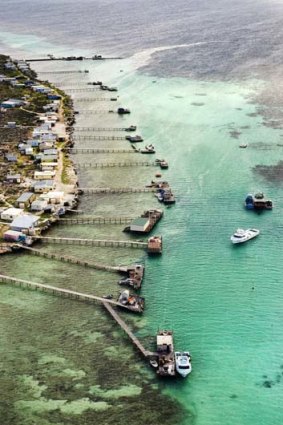
Ragged reefs ... jetties extend from a cluster of Houtman Abrolhos islands.Credit: Getty Images
The wreck of the Batavia looms large as Daniel Scott approaches the remote Houtman Abrolhos islands.
For days before I visit the Houtman Abrolhos islands, an archipelago of 122 islands anchored at the edge of the continental shelf off Western Australia, I serially mispronounce its name. Somehow, a name derived from an early 17th-century Dutch mariner - Houtman - and a word of Portuguese origin - Abrolhos, mistakenly taken to mean "open your eyes" - seemed too exotic for their location 60 kilometres off the unremarkable town of Geraldton.
Now that we're flying above them on a day tour with Geraldton Air Charter, my linguistic confusion isn't easing. At the small aircraft's controls is a pilot of Hungarian heritage, Balazs (pronounced "Blanche") Marcus, and down below, the warm Leeuwin Current flows through channels called Zeewijk and Geelvink and nudges islands with names such as Pelsaert, Suomi and Wallabi, spelt with an "i", not a "y".
Low, rocky and clustered around emerald-turquoise bays, the Abrolhos wouldn't seem out of place in the Mediterranean. Nor would many of the fishermen drawn to these esoteric parts by the proliferation of western rock lobsters.
"They came from all around the world," Marcus tells us, "including Norway, Denmark, Japan and Greece but particularly Italy. During the 1940s and '50s, it was mostly migrants from Sicily and it's those families that still form the nucleus of the fishing community."
In the rock lobster season, which usually runs from March to June, the fishermen occupy camps of brightly painted shacks on 22 islands, some with their own school and pub. Harvesting the lobsters, which live in crevices at the edge of limestone reefs, is a multimillion dollar business; the fishermen harvest up to 5 million kilograms a year.
The European connection with the Abrolhos goes back to 1619, more than 150 years before Captain Cook set foot on the east coast, when the islands were first sighted by Dutch ships. Noting the "level, broken country with reefs all round it", Frederic de Houtman, an officer aboard one ship, warned the islands were "very dangerous to ships".
Unfortunately, Houtman's message went unheeded by Commander Pelsaert and the crew of another Dutch ship, the Batavia, which, 10 years later, ran aground in the archipelago. The wreck was just part of a gory story of mutiny, murder, survival and retribution that played out among the islands during 1629. The saga is one of the most dramatic in Australian history and has spawned an opera and several books, including the recent bestseller Batavia by author Peter FitzSimons.
When Pelsaert and some crew took off for help in a longboat, a larger group of survivors, led by Jeronimus Cornelisz, stayed behind on Beacon Island. With rations short and Pelsaert's return in doubt, Cornelisz's followers proceeded to murder more than 100 men, women and children.
The only real opposition came from a small group of soldiers under the command of Wiebbe Hayes, who established themselves away from Cornelisz on West Wallabi Island. The loose-stone fort they constructed there was the first European edifice built on Australian soil. When Pelsaert miraculously returned months later, Cornelisz and his henchmen were tried and hanged for their crimes.
Our plane has just circled the remains of Hayes's fort when it's time to land on neighbouring East Wallabi, three kilometres long, 1.8 kilometres wide. We walk to sweeping Turtle Bay, careful not to disturb a pair of sea eagles nesting in the dunes, then snorkel in water that never dips much beneath 22 degrees thanks to the tropical Leeuwin Current.
The warm flow is also responsible for the extensive coral gardens just offshore, part of the Indian Ocean's most southerly reef system. We hover over staghorn and plate formations that range in colour from brilliant white to lilac and dark purple and swim among tropical and temperate fish species. Although we don't spot any of the Abrolhos's population of Australian sea lions today, we see turtles and dolphins riding waves to the beach.
Back on land, we find several tammar wallabies shading themselves in the scrub and a two-metre high osprey nest built from beach debris. Altogether the Abrolhos is inhabited by 90 species of seabird, including noddies, terns and shearwaters.
As our plane banks away from the islands, we're left with an abiding image of their early European history: the wreck of the Batavia, nearly 400 years old, still clearly visible on the reef it foundered on.
Daniel Scott travelled courtesy of Geraldton Air Charter and Coral Coast Tourism.
FAST FACTS
Getting there
Perth is the nearest major airport. The major domestic airlines fly from Sydney (5hr, about $240) and Melbourne (4hr 10min, about $320). Skywest Airlines flies from Perth to Geraldton (80min) for about $150. Fares are one-way including tax.
Touring there
Geraldton Air Charter has day tours to the Abrolhos for $240. Phone (08) 9923 3434, see geraldtonaircharter.com.au.
Staying and eating there
There is no visitor accommodation on the Abrolhos. In Geraldton, the Broadwater Mariner resort is close to the marina with apartment-style accommodation from $175 a night; phone (08) 9965 9100, see mariner.broadwaters.com.au.
Try local seafood at Saltdish Cafe, 35 Marine Terrace, or The Boatshed, 359 Marine Terrace.
More information
See australiascoralcoast.com.
Sign up for the Traveller Deals newsletter
Get exclusive travel deals delivered straight to your inbox. Sign up now.